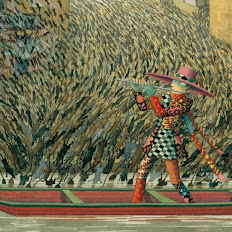Ratcatchers Day is celebrated on the 26th June or the 22nd of July, more commonly on the 22nd July.
Ratcatchers Day commemorates the Pied Piper of Hamelin, the most infamous of rat catchers. Today is the anniversary of the legendary event of the Pied Piper of Hamelin. I find this illustration by Emma Chichester Clark from Michael Morpurgo's retelling of the tale quite scary. She certainly has rats in plague proportions.
Should The Pied Piper of Hamelin be a children's story, given what happens to the children? Read this summary of the story.
One of the most well-known German folklore is the story of the Pied Piper of Hamelin. Hamelin, Germany was infested by rats. So, the mayor promised to handsomely pay the Pied Piper if he rid the town of rats. The Pied Piper played his flute. Lured by the magical music, all of the rats left town and followed him. He played his music all the way down to the Weser River. He waded into the river. When the rats followed him they drowned.
The mayor refused to pay him. So, one night when the townspeople were asleep, the Pied Piper played his music again. This time, the children of the town followed him into a cave. Some versions of the legend vary here. One version says the Pied Piper kept them there until he was paid by the town for his services. In most versions, the children were never to be seen again.
In addition to the Pied Piper of Hamelin, this day recognises the hard work of all Ratcatchers. It’s a tough job, but somebody’s got to do it. So, if you see a hardworking Pest Control Professional, let them know you appreciate the work that they do.
The poet, Robert Browning told this story in a long poem, not necessarily intended for children, but this story has been included in fairy tale anthologies and made into picture books so it is now considered a children's story. In the current time of childhood I don't think parents would think the historic version appropriate, but many of the more recent publications have sanitised it somewhat and usually the children survive.
The version I enjoy sharing the most is The Pied Piper by Ayesha L. Rubio. On the cover you will read 'adapted by' because in this modern version of the tale Rubio has an imaginative twist at the end. It's lighter tone has the mayor still refusing to pay and the piper taking the children away, but when the children disappear, the mayor is run out of town by their parents and the piper brings the children and the rats back.When this book was published, I remember reviewers saying that they found the ending less than satisfactory, but as my students are all under 8 years old and this is a much more reconciliatory ending I think this works well with young children.
Rubio's illustrations are a delight and each rat is imbued with mischief, right up to the last page.The Child's Play version The Pied Piper of Hamelin by Natalia Vasquez is also suitable for younger readers. Jane Ray's The Pied Piper of Hamelin is wordless so it allows for readers to tell their own story.

If you want to read a more traditional version with more text look for:
• The Pied Piper of Hamelin by Michael Morpurgo and Emma Chichester Clark
• The Pied Piper of Hamelin by Maren Briswalter







No comments:
Post a Comment